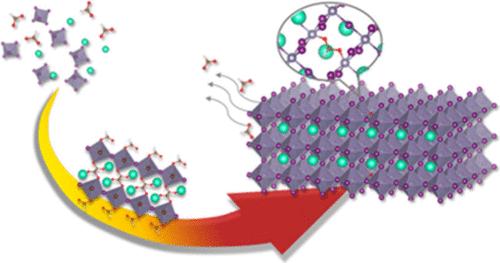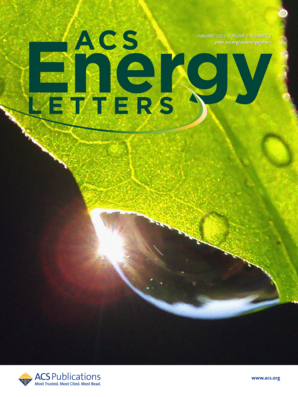效率超过 13.6% 的无机 CsSnI3 Perovskite 太阳能电池
IF 19.3
1区 材料科学
Q1 CHEMISTRY, PHYSICAL
引用次数: 0
摘要
由于 Sn2+ 的路易斯酸度较高,制备高质量的 CsSnI3 薄膜是一项重大挑战。为了解决这一关键问题,我们在此提出了一种假卤化物阴离子合金化工艺,以调节无机 CsSnI3 包晶的结晶,实现微米级的大晶粒尺寸。假卤化物阴离子的引入通过形成中间产物改变了相变途径,从而减缓了 CsSnI3 的结晶速度。由于 HCOO- 阴离子和 Sn2+ 阳离子之间的强键作用,CsSnI3 晶格中的 HCOO- 替代合金进一步提高了 Sn2+ 的抗氧化性。所制备的基于 CsSnI3 的平面透辉石太阳能电池采用倒置结构,有源面积为 4.05 mm2,在 AM 1.5 太阳辐照(100 mW cm-2)条件下的功率转换效率为 13.68%,是所报道的基于 CsSnI3 的无机透辉石电池中最好的。本文章由计算机程序翻译,如有差异,请以英文原文为准。

Inorganic CsSnI3 Perovskite Solar Cells with an Efficiency above 13.6%
Due to the high Lewis acidity of Sn2+, it is a major challenge to prepare high-quality CsSnI3 films. To solve this critical problem, here we propose a pseudohalide anion alloying process to regulate the crystallization of inorganic CsSnI3 perovskite and achieve large grain sizes in the micron range. The introduction of a pseudohalide anion changes the phase transition pathways through the formation of intermediates, thereby slowing the rate of CsSnI3 crystallization. The substitutional alloying of HCOO– in the CsSnI3 crystal lattice further improves the oxidation resistance of Sn2+ due to the strong bonding between the HCOO– anions and Sn2+ cations. The fabricated CsSnI3-based planar perovskite solar cell with an inverted configuration and active area of 4.05 mm2 exhibits certified power conversion efficiency of 13.68% at AM 1.5 solar irradiation (100 mW cm–2), which is among the best reported for CsSnI3-based inorganic perovskite cells.
求助全文
通过发布文献求助,成功后即可免费获取论文全文。
去求助
来源期刊

ACS Energy Letters
Energy-Renewable Energy, Sustainability and the Environment
CiteScore
31.20
自引率
5.00%
发文量
469
审稿时长
1 months
期刊介绍:
ACS Energy Letters is a monthly journal that publishes papers reporting new scientific advances in energy research. The journal focuses on topics that are of interest to scientists working in the fundamental and applied sciences. Rapid publication is a central criterion for acceptance, and the journal is known for its quick publication times, with an average of 4-6 weeks from submission to web publication in As Soon As Publishable format.
ACS Energy Letters is ranked as the number one journal in the Web of Science Electrochemistry category. It also ranks within the top 10 journals for Physical Chemistry, Energy & Fuels, and Nanoscience & Nanotechnology.
The journal offers several types of articles, including Letters, Energy Express, Perspectives, Reviews, Editorials, Viewpoints and Energy Focus. Additionally, authors have the option to submit videos that summarize or support the information presented in a Perspective or Review article, which can be highlighted on the journal's website. ACS Energy Letters is abstracted and indexed in Chemical Abstracts Service/SciFinder, EBSCO-summon, PubMed, Web of Science, Scopus and Portico.
 求助内容:
求助内容: 应助结果提醒方式:
应助结果提醒方式:


